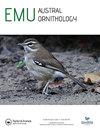Where are you from? Isotopic tracing of juvenile Olrog’s Gulls from Mar Chiquita during the wintering season
IF 1.1
4区 生物学
Q3 ORNITHOLOGY
引用次数: 0
Abstract
ABSTRACT Individual traits such as age-class can have profound effects on space utilisation by individual birds, with juvenile birds more often exhibiting dispersive movements. We studied the origin of juvenile Olrog’s Gulls Larus atlanticus, a threatened species, using stable isotopes ratios of carbon (δ13C), nitrogen (δ15N) and sulphur (δ34S). We analysed feathers from individuals captured in the wintering season at Mar Chiquita Coastal Lagoon, Argentina, and the potential trophic sources of their breeding sites at Bahía Blanca and San Blas. Mean δ13C was similar for trophic sources and mean δ15N was higher for Bahía Blanca. The δ34S showed a greater variation among prey species than among sites. The mean contributions of the main colonies resulted in assigning 37.5% individuals as from Bahía Blanca, 16.7% from San Blas, and 45.8% undetermined. Results indicate that Mar Chiquita coastal lagoon attracts juvenile Olrog’s Gulls dispersing from the two main breeding grounds of the species. This work is one of the first approaches to study the origin of dispersive juvenile larids through the application of stable isotope analysis. This isotopic approach allows obtaining trophic and movement information when it is not possible to use other tools.你是哪里人?奇基塔海幼鸥越冬期的同位素追踪
个体特征(如年龄等级)对个体鸟类的空间利用有着深远的影响,幼鸟更经常表现出分散的运动。利用碳(δ13C)、氮(δ15N)和硫(δ34S)的稳定同位素比值,对濒危物种大西洋鸥幼鸥的起源进行了研究。我们分析了在阿根廷Mar Chiquita海岸泻湖冬季捕获的个体的羽毛,以及它们在Bahía Blanca和San Blas繁殖地的潜在营养来源。各营养源的平均δ13C相似,Bahía Blanca的平均δ15N较高。δ34S在猎物种间的差异大于地点间的差异。主要群体的平均贡献导致37.5%的个体来自Bahía布兰卡,16.7%来自圣布拉斯,45.8%未确定。结果表明,Mar Chiquita海岸泻湖吸引了从该物种的两个主要繁殖地分散的幼鸥。这项工作是首次应用稳定同位素分析方法研究分散性幼虫起源的方法之一。当不可能使用其他工具时,这种同位素方法可以获得营养和运动信息。
本文章由计算机程序翻译,如有差异,请以英文原文为准。
求助全文
约1分钟内获得全文
求助全文
来源期刊

Emu-Austral Ornithology
生物-鸟类学
CiteScore
2.00
自引率
7.70%
发文量
33
审稿时长
>12 weeks
期刊介绍:
Emu – Austral Ornithology is the premier journal for ornithological research and reviews related to the Southern Hemisphere and adjacent tropics. The journal has a long and proud tradition of publishing articles on many aspects of the biology of birds, particularly their conservation and management.
 求助内容:
求助内容: 应助结果提醒方式:
应助结果提醒方式:


